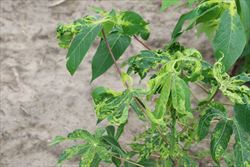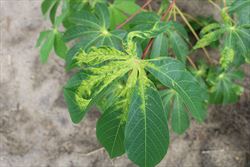- Restricted. Asia, Africa. Not recorded from Oceania. 10 strains of cassava mosaic virus (CMV). Most are in Africa (African cassava mosaic virus ACMV; three in Asia (ACMV, Indian ICMV, and Sri Lankan SLCMV).
- Major disease of cassava and wild relatives, but also found wild in some members of legume family.
- Symptoms variable between leaves, shoots and plants. Leaves with yellow and green patches (mosaics), deformed; shoots stunted. In general, more severe the symptoms, greater the loss in root yield. Note: (i) impact greater if symptoms occurs in first 3 months; (ii) infected plants do not always show symptoms; (iii) some cutting from infected plants free from virus.
- Spread: stem cutting and whiteflies over short distances (whiteflies by flight), over long distances on the wind. Need 3 hours to acquire virus, 8 hours wait until infective, then 10 minutes to infect healthy plants.
- Biosecurity: risk is unofficial introduction of diseased planting material. Official movement of germplasm should follow FAO/IPBGR Technical Guidelines.
- Biocontrol: The fungi Isaria farinosa and Isaria fumosorosea considered. Predators of whiteflies identified: lacewings, big-eyed bugs, coccinellid beetles, hoverflies.
- Cultural control: cuttings from disease-free source (monitor previous crop or use cuttings from government schemes); avoid planting next to (i) infested cassava; (ii)alternative hosts, e.g., castor oil; (iii) whitefly hosts, e.g., sweet potato; plant varieties with different resistance; rogue diseased plants in first 3 months, and as soon as symptoms seen; use resistant varieties (e.g., ITTA/national breeding programs)
- Chemical control: avoid broad-spectrum insecticides; use white oil, petroleum oil or insecticidal soap; alternatively, use chilli, neem or derris (see Fact Sheet nos. 56, 402, 504).
Pacific Pests, Pathogens and Weeds - Online edition
Pacific Pests, Pathogens, Weeds & Pesticides
Cassava mosaic diseases (520)
Cassava mosaic virus diseases.
There are several virus strains causing cassava mosaic virus diseases, and their names tell from where they were found. Initially three strains (African cassava mosaic virus, East African cassava mosaic virus, Indian (and Sri Lanka) cassava mosaic virus) were isolated and, later, strains within these groups were identified as sequencing methods developed. Presently, more than 10 strains are recognised, with more likely.
Originally, the virus was named cassava latent virus; this was because the geminiviruses (twinned particles with circular strands of DNA) that were later found to cause the mosaic were so difficult to detect in diseased plants, either under the electron microscope or in sap-inoculation tests to the virus-indicator plant, Nicotiana clevelandii. Once the exact nature of the virus was known, strains were identified based on their geography and serology, and nowadays by molecular assays. The viruses have been classified as members of the Geminiviridae family, and they are spread by whiteflies. The abbreviation of African cassava mosaic virus is ACMV.
AUTHOR Grahame Jackson
Information from Uke A, et al. Cassava mosaic disease and its management in Southeast Asia. Plant Mol Biol (2021). (https://doi.org/10.1007/s11103-021-01168-2); and CABI (2021) African cassava mosaic (African cassava mosaic). Crop Protection Compendium. (https://www.cabi.org/cpc/datasheet/2747); and Boa E, et al. (2015) Cassava mosaic disease. In: Crop pests and diseases: A manual on the most important pests and diseases of the major foood crops grown by smaller farmers bn Africa. Africa Soil Health Consortium. CABI International, Wallingford, UK. (http://africasoilhealth.cabi.org/wpcms/wp-content/uploads/2015/09/519-ASHC-manual-English.pdf); and Zhang P, et al. (2005) Resistance to cassava mosaic disease in transgenic cassava expressing antisense RNAs targeteing virus replication genes. Journal of Pant Biotechnology 3(5):385-97). (doi: 10.1111/j.1467-7652.2005.00132.x); and from Daniel ZJ (2019) Engineering disease-resistant cassava. Cold Spring Harbor perspectives in biology 11(11). (https://cshperspectives.cshlp.org/content/11/11/a034595).
Photo 1 Phil Taylor (CABI). (https://www.cabi.org/cpc/datasheet/2535); Photos 2&3 H. Holmes Cassava mosaic disease (CMD) symptoms in a field in Tanzania. (https://www.flickr.com/photos/129099219@N03/32638164343/in/photolist-RJ88ar-TAZ1CH-nfsGJs-88VdGX-RJ88o2-cqiaZ9-81L8yB-Tpxydv-2dPfti-adke4r-SjpWxC-TpxxFZ-UbgMz3-TAZ1jr-dWUT2E-SjpWqo-fuhYHs-dWUK3j-TAYZG4-T1ZHcC-Tpxy1g-TpxxP4-fuigZA-fu49Gp-fu16Ug-SjpVUo-fu47wi-Txmsw9-c15D8s-dWPbfc-dWPcz2-fuhvz3-fuhD7G-fuivAL-dWUFNq-fu3g3V-fu1Te8-fu2kjP-fugGrf-fu2aZ2-ftZXiF-fu19Kt-fuhFNu-dWPffp-fuhPiq-fuhJLh-fu3vXD-fufErA-ftZVLD-fu1fA6), and (https://www.flickr.com/photos/129099219@N03/32638165073/in/photolist-RJ88o2-cqiaZ9-81L8yB-Tpxydv-2dPfti-adke4r-SjpWxC-TpxxFZ-UbgMz3-TAZ1jr-dWUT2E-SjpWqo-fuhYHs-dWUK3j-TAYZG4-T1ZHcC-Tpxy1g-TpxxP4-fuigZA-fu49Gp-fu16Ug-SjpVUo-fu47wi-Txmsw9-c15D8s-dWPbfc-dWPcz2-fuhvz3-fuhD7G-fuivAL-dWUFNq-fu3g3V-fu1Te8-fu2kjP-fugGrf-fu2aZ2-ftZXiF-fu19Kt-fuhFNu-dWPffp-fuhPiq-fuhJLh-fu3vXD-fufErA-ftZVLD-fu1fA6-dWP8fK-fuhW2G-fuhLV1-fu13MX). Photo 4 Stephan Winter, DSMZ-German Collection of Microorganisms and Cell Cultures Braunschweig, Germany.
Produced with support from the Australian Centre for International Agricultural Research under project HORT/2016/185: Responding to emerging pest and disease threats to horticulture in the Pacific islands, implemented by the University of Queensland, in association with the Pacific Community.







